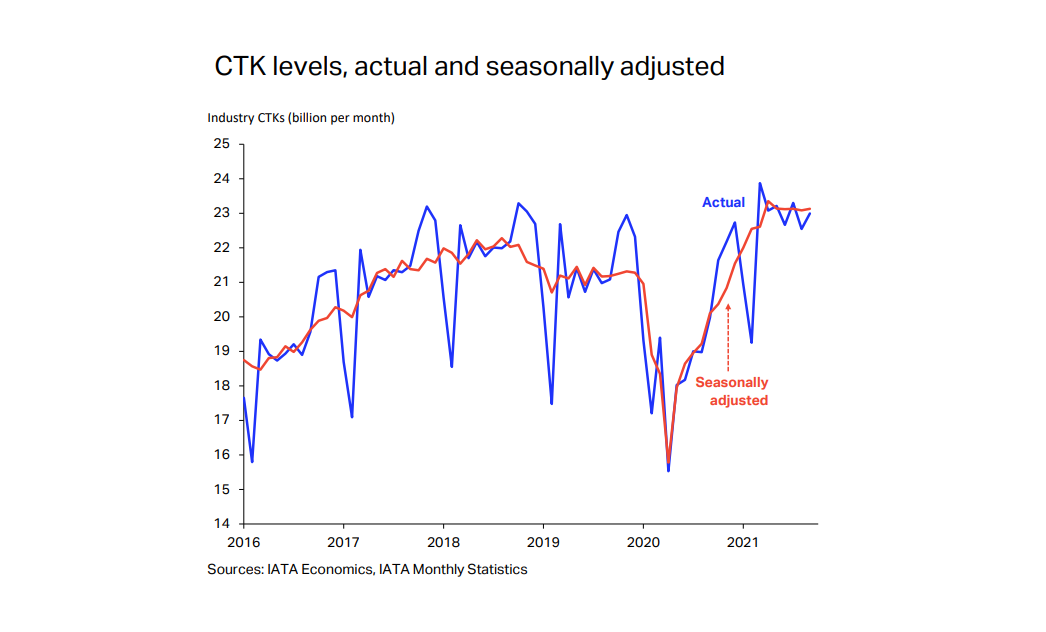
Air cargo just 3x costly than shipping compared to 12x pre-Covid: IATA
Global demand, measured in cargo tonne-kilometres (CTKs), was up 9.1 percent compared to September 2019 (9.4 percent for international operations) while capacity remained constrained at 8.9 percent below pre-Covid levels (September 2019) (-12 percent for international operations).

The International Air Transport Association (IATA) released September 2021 data for global air cargo markets showing that global demand, measured in cargo tonne-kilometres (CTKs), was up 9.1 percent compared to September 2019 (9.4 percent for international operations) while capacity remained constrained at 8.9 percent below pre-Covid levels (September 2019) (-12 percent for international operations).
Supply chain disruptions and the resulting delivery delays have led to long supplier delivery times. This typically means manufacturers use air transport, which is quicker, to recover time lost during the production process. The September global Supplier Delivery Time Purchasing Managers Index (PMI) was at 36, values below 50 are favourable for air cargo.
The September new export orders component and manufacturing output component of the PMIs have deteriorated from levels in previous month but remain in favourable territory. Manufacturing activity continued to expand at a global level but, there was contraction in emerging economies.
The inventory-to-sales ratio remains low ahead of the peak year-end retail events such as Single’s Day, Black Friday and Cyber Monday. This is positive for air cargo, however, further capacity constraints put this at risk.
The cost-competitiveness of air cargo relative to that of container shipping remains favourable. Pre-crisis, the average price to move air cargo was 12.5 times more expensive than sea shipping. In September 2021 it was only three times more expensive.
Willie Walsh, IATA’s director-general, said, “Air cargo demand grew 9.1 percent in September compared to pre-Covid levels. There is a benefit from supply chain congestion as manufacturers turn to air transport for speed. But severe capacity constraints continue to limit the ability of air cargo to absorb extra demand. If not addressed, bottlenecks in the supply chain will slow the economic recovery from Covid. Governments must act to relieve pressure on global supply chains and improve their overall resilience.”
Asia-Pacific airlines saw their international air cargo volumes increase 4.5 percent in September 2021 compared to the same month in 2019. This was a slowdown in demand compared to the previous month’s 5.1 percent expansion. Demand is being affected by slowing manufacturing activity in China. International capacity is significantly constrained in the region, down 18.2 percent vs. September 2019. Looking forward, the decision by some countries in the region to lift travel restrictions should provide a boost for capacity.
North American carriers posted a 19.3 precent increase in international cargo volumes in September 2021 compared to September 2019. New export orders and demand for faster shipping times are underpinning North American performance. International capacity was down 4.0 precent compared to September 2019, a slight improvement from the previous month.
European carriers saw a 5.3 precent increase in international cargo volumes in September 2021 compared to the same month in 2019. This was on a par with August’s performance (5.6 precent). Demand was strongest on the large North Atlantic trade lane (up 6.9 precent vs September 2019). Performance on other routes was weaker. Manufacturing activity, orders and long supplier delivery times remain favourable to air cargo demand. International capacity was down 13.5 precent on September 2019.
Middle Eastern carriers experienced a 17.6 precent rise in international cargo volumes in September 2021 versus September 2019, an improvement compared to the previous month (14.7 precent). International capacity was down 4 precent compared to September 2019.
Latin American carriers reported a decline of 17.1 precent in international cargo volumes in September compared to the 2019 period, which was the weakest performance of all regions. This was also slightly worse than the previous month (a 14.5 precent fall). Capacity in September was down 20.9 precent on pre-crisis levels, an improvement from August, which was down 24.2 precent on the same month in 2019.
African airlines’ saw international cargo volumes increase by 34.6 precent in September, the largest increase of all regions for the ninth consecutive month. Seasonally-adjusted volumes are now 20 precent above pre-crisis 2019 levels but have been trending sideways for the past six months. International capacity was 6.9 precent higher than pre-crisis levels, the only region in positive territory, albeit on small volumes.

